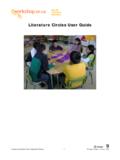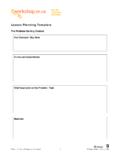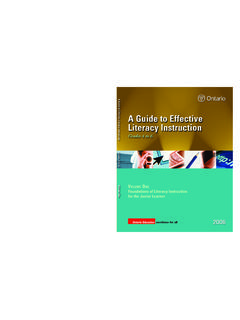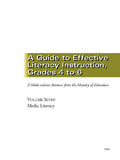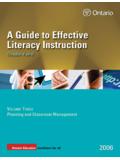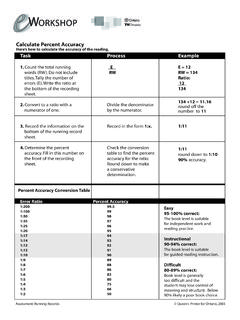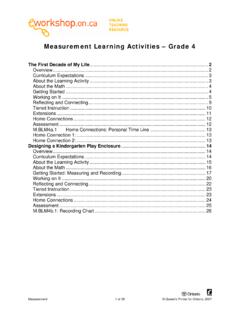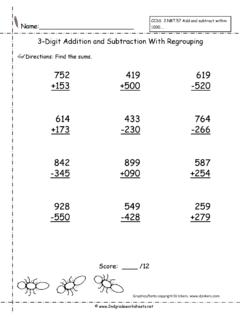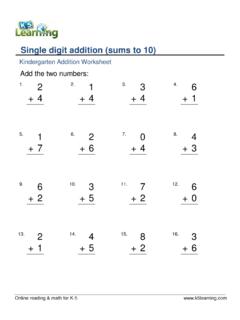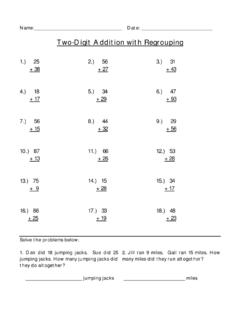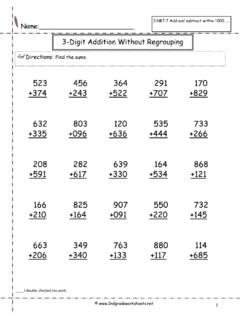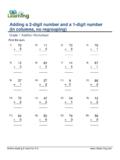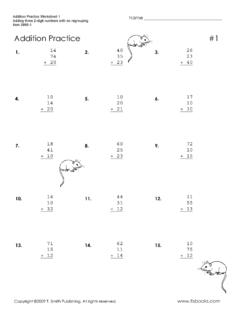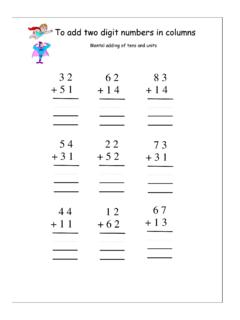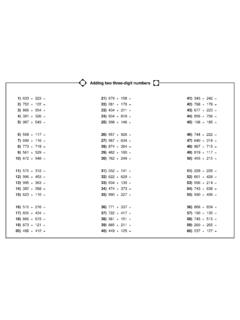Transcription of A Guide to Effective Instruction in Mathematics - eWorkshop
1 A Guide to EffectiveInstruction in MathematicsA Guide to EffectiveInstruction in MathematicsKindergarten to Grade 6A Resource in Five Volumes from the Ministry of EducationVVoolluummee FFiivvee TTeeaacchhiinngg BBaassiicc FFaaccttss aanndd MMuullttiiddiiggiitt CCoommppuuttaattiioonnssEvery effort has been made in this publication to identify Mathematics resources and tools( , manipulatives) in generic terms. In cases where a particular product is used by teachersin schools across Ontario, that product is identified by its trade name, in the interests of clarity. Reference to particular products in no way implies an endorsement of those productsby the Ministry of publication quivalente est disponible en fran ais sous le titre suivant : Guide d enseignement efficace des math matiques, de la maternelle la 6eann ..v10. Approaches to Teaching Basic Facts and Multidigit Computations ..1 Introduction ..5 Using the Problem-Solving Approach to Teach Basic Facts and Multidigit Computations.
2 7 Basic Facts: Addition and Subtraction, and Multiplication and Division .. 12 Basic Addition and Subtraction Facts .. 20 Basic Multiplication and Division Facts .. 27 Multidigit Whole Number Calculations .. 35 Appendices .. 57 References .. 113 ContentsvIntroductionThis is Volume Five of the five-volume reference Guide A Guide to Effective Instructionin Mathematics , Kindergarten to Grade 6. This volume contains Chapter 10. Chapter 10is devoted to the important subject of teaching basic facts and multidigit computa-tions the building blocks of students computational proficiency. Effective instruc-tion in this area is critical, as students ability to perform operations accurately andwith understanding will affect their achievement of expectations in all five strands ofthe curriculum. The chapter lays out the approaches and strategies that have provedmost Effective in helping students understand, learn, and consolidate their learningof the basic facts. Games and activities, with accompanying blackline masters, arealso included here, to give teachers useful ideas for teaching the strategies to theirstudents.
3 * (See the Introduction of Volume One for a summary of the organizationand contents of the complete five-volume Guide .)A list of suggested professional resources for teachers and administrators is includedin Volume One. It is meant to provide useful suggestions, but should not be consid-ered comprehensive. A glossary of terms used throughout the Guide is also providedat the end of Volume One. References are listed at the end of each individual volume. This Guide contains a wide variety of forms and blackline masters, oftenprovided in appendices, that teachers can use in the classroom. Electronicversions of all of these materials can be found at electronic forms and blackline masters are in a Word format thatcan be modified by teachers to accommodate the needs of their students.*Basic facts and multidigit computations are the focus of a group of expectations in the Number Senseand Numeration strand of the Ontario Mathematics curriculum. The companion documents to this guidethat focus on the Number Sense and Numeration strand also contain information and learning activitiesrelating to basic facts and multidigit to electronic versions of theforms and blackline mastersprovided throughout thisguide.
4 They can be modifiedto meet classroom Guide to Effective Instruction in Mathematics , Kindergarten to Grade 6 Volume FiveLocating Information Specific to Kindergarten, Primary, and JuniorStudents in This GuideAn important feature of this Guide is the inclusion of grade-related information and examples that help clarify the principles articulated. Such information is identified in the margins of this Guide by means oficons referring to the relevant grades K for Kindergarten, Grades 1 3 for primary, Grades 4 6 for junior. Examples and other materials that areappropriate for use at more than one level or are applicable to more thanone level are identified by the appropriate combination of Kindergarten1 3 Primary4 6 JuniorLook for the following icons inthe margins of this document: ..5 Using the Problem-Solving Approach to Teach Basic Facts and Multidigit Computations ..7 Problems for Basic Facts of Addition and Subtraction, and for Multidigit Computations Using Addition and Subtraction.
5 8 Types of Problems ..9 Problems for Basic Facts of Multiplication and Division, and for Multidigit Computations UsingMultiplication and Division .. 10 Types of Problems .. 11 Basic Facts: Addition and Subtraction, and Multiplication and Division .. 12 Principles for Teaching the Facts .. 13 Prior Learning Necessary for Developing Computational Sense .. 13 Developing Computational Sense .. 14 Direct Modelling and Counting .. 15 Counting Strategies .. 15 Making Tens .. 15 Derived Facts .. 16 Using Worksheets With a Purpose .. 17 Strategy Flash Cards .. 18 Timed Tests .. 19 Approaches to Teaching Basic Facts and MultidigitComputations Chapter Contents2A Guide to Effective Instruction in Mathematics , Kindergarten to Grade 6 Volume FiveBasic Addition and Subtraction Facts .. 20 Using Models to Represent Facts of Addition and Subtraction .. 20 Strategies for Basic Facts of Addition and Subtraction .. 21 One-More-Than and Two-More-Than Facts.
6 23 Facts With Zero .. 23 Doubles .. 24 Near-Doubles or Doubles Plus One .. 24 Make-Ten Facts .. 25 Commutative Property .. 25 Subtraction as Think-Addition for Facts With Sums to 10 .. 25 Subtraction as Adding Up .. 25 One-Less-Than and Two-Less-Than Facts .. 26 Counting by Twos and Fives .. 26 Make Ten Extended .. 26 Back Down Through Ten .. 26 Practice and Consolidation of Facts for Additionand Subtraction .. 26 Basic Multiplication and Division Facts .. 27 Thinking About Multiplication and Division .. 27 Basic Multiplication Facts .. 28 Basic Division Facts .. 28 Using Models to Represent Facts of Multiplicationand Division .. 28 Strategies for Basic Facts of Multiplication and Division .. 30 Commutative Property .. 31 Rules for Zero and One .. 31 Doubles .. 32 Double and Double Again .. 32 Double and One More Set .. 32 Five Facts .. 32 Add One More Set .. 32 Nine Times Table .. 32 Half Then Double.
7 33 Inverse Relationship of Division and Multiplication .. 33 Learning the Division Facts in Sequence .. 34 Practice and Consolidation of Facts for Multiplicationand Division .. 34 Approaches to Teaching Basic Facts and Multidigit Computations3 Multidigit Whole Number Calculations .. 35 Teaching Multidigital Computations .. 39 Steps for Working Through a Multidigit Problem .. 41 Student-Generated Computational Strategies .. 42 Examples of Student-Generated Computational Strategies .. 42 Criteria for Student-Generated Computational Strategies .. 44An Investigative Approach to Working With Multidigit Computations .. 44 Activities to Help Students Develop Strategies for Multidigit Computations .. 46 Hundreds Chart .. 46 Human Calculator Game .. 47 Open Number Line .. 47 Reach the Target .. 48 Add On .. 49 Double Tens and Near-Double Tens .. 50 The Target Number Game .. 50 The Winning Number .. 51 The Longest Computation.
8 51 Start With the Solution .. 51 Standard Algorithms .. 52 Progression for Teaching Standard Algorithms .. 52 Estimation .. 54 AppendicesAppendix 10-1: Approaches That Help Students UnderstandStandard Algorithms .. 57 Appendix 10-2: Instructions for Games and Activities .. 69 Appendix 10-3: Blackline Masters .. 795 IntroductionThis chapter focuses on the development of students facility in using whole numbersin single-digit and multidigit computations. Single-digit computations used to be called basic facts , but many organizations now call them basic number combinations (Kilpatrick,Swafford, & Findell, 2001). Basic facts include the addition, subtraction, multiplica-tion, and division of numbers from 0 to 9. Multidigit computations include all combi-nations of numbers of two or more digits in addition, subtraction, multiplication, the past, the emphasis in teaching was on memorization of the basic number facts,sometimes to the exclusion of establishing a firm foundation of number sense.
9 Presentresearch supports the importance of developing conceptual understanding for futuresuccess in Mathematics (National Council of Teachers of Mathematics , 2000). Researchalso demonstrates that Instruction that focuses on conceptual understanding improvesnumerical reasoning and procedural fluency and accuracy (National Research Council,2001). Understanding the structures that underlie single-digit basic facts also givesstudents an Effective tool for working with multidigit computations. However, it isoften the case that Instruction does not focus on the mathematical concepts inherentin multidigit computations. Instead, it focuses almost entirely on the on memorized procedures prevents students from using mathematicalreasoning. Students may persist with a regrouping procedure to solve 2000 50,come up with an answer such as 1050, and not be aware that one step in the procedureis missing and that the answer is wrong by a significant amount. Students who havedeveloped reasoning skills through their work with single-digit numbers will be morelikely to extend this reasoning into multidigit computations and to recognize that ananswer that is almost 1000 less than the minuend cannot be right.
10 Learning the basic facts conceptually involves developing an understanding of therelationships between numbers ( , 7 is 3 less than 10 and 2 more than 5) and ofApproaches to Teaching Basic Facts and Multidigit Computations6A Guide to Effective Instruction in Mathematics , Kindergarten to Grade 6 Volume Fivehow these relationships can be developed into strategies for doing the computationsin a meaningful and logical manner. Students who learn the basic facts using a varietyof strategies (making tens, using doubles) will be able to extend these strategies andtheir understanding of number to multidigit computations. In the primary grades,students begin to develop their understanding of the basic facts by making concreterepresentations of numbers ( , representing 4 with cubes). They use their developingsense of more , less , and the same to understand that 6 cubes is more than 4 the next stage, they physically join quantities ( , 3 cubes joined to 4 cubes) anduse their developing counting skills to count all the cubes to find a solution.
